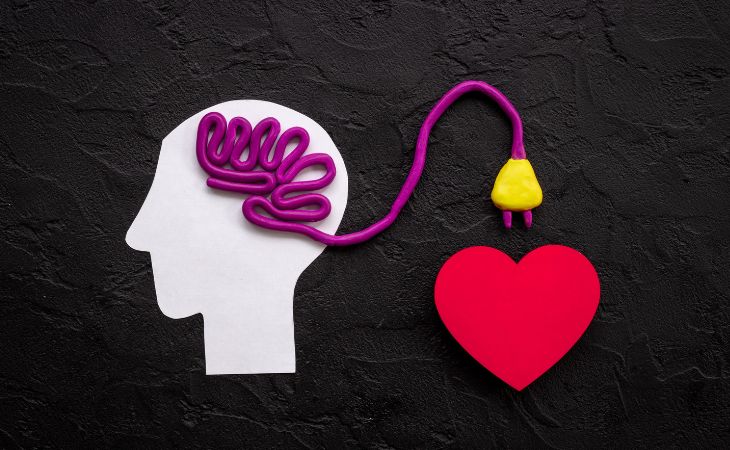How are negative emotions trapped within us?
As early as 1992, a study was published supporting the connection between the body and the mind, and more recent studies show that our mental health affects our physical health. A classic example is fear; if you are in a situation where you experience fear, the body responds with a "fight or flight" reaction. In his book "The Emotion Code," Dr. Bradley Nelson describes three things that happen when we experience emotion:
1. We develop an emotional frequency.
2. We experience the emotion and all the thoughts and physical sensations that accompany it.
3. We process the emotion and move on.
According to a study published in 2017, the emotional processing stage occurs in the limbic system of the brain, which is also responsible for survival and regulates body temperature, blood pressure, and blood sugar levels. As we constantly process new information, there is always an automatic response from our nervous system, which sends signals to the body and triggers emotional reactions that correspond to the experience. In other words, our emotions come from what the nervous system tells our body and us.

According to Nelson, when there is an interruption in the second or third stages described, the emotional energy becomes trapped in the body, and as a result, we experience physical responses such as tight muscles, pain, and other issues. Many psychologists argue that the problem here is that our "true self" (the curious and confident part of us) wants to express something that the "false self" (the part that learned to cope with pain and loss) does not want us to express. This is essentially the repression of negative energy, and it manifests as:
- Holding grudges
- Poor judgment
- Self-sabotage
- Overreacting
- Stress and anxiety
- Depression
- Exhaustion
The connection between trapped negative emotions and trauma
It's almost impossible to talk about this topic without bringing up emotional trauma and how the brain experiences it. The truth is that almost everyone will experience trauma at some point in their lives, and a study from 2015 conducted among 69,000 people worldwide showed that over 70% of respondents had experienced a traumatic event in their lives, and about 30% of them experienced 4 or more traumatic events. Trauma can arise in life due to experiences such as:
- Breakup or divorce
- Significant life changes
- Serious illness
- Death of a loved one
- Betrayal in a relationship
- Loss of a job or the ability to work
- Experiencing violence, discrimination, or racism
Trauma affects our memory processing and the ability to retrieve factual information from the experience we went through. When it comes to a particularly intense experience, the brain may process the memory as an image or a certain sensation in the body. When a specific trigger that evokes this memory arises, the brain disconnects from reality and tries to recreate the traumatic event, which comes in the form of a flashback. This entire process disrupts the brain’s natural healing ability, and the experience that is trapped in it causes us to remain stuck in the past. This is clearly seen in people who suffer from post-traumatic stress disorder, a condition that usually develops after a particularly frightening or threatening experience.
Where are emotions trapped within the body?
Have you ever wondered why a person who is angry is called "hot-headed"? Have you ever felt pressure in your chest due to anxiety? Or maybe you’ve felt your "heart sink" because of fear? The physical sensations created by our emotions vary from person to person, but a team of biomedical engineers from Finland tried to map this phenomenon in a study from 2013 and show exactly where emotions are located in the body. They asked 700 people where they felt an increase or decrease in sensation during the experience of strong emotions, and here’s what they found:

These researchers conducted a follow-up study published in 2018, in which they showed that the intensity of the emotion affects the intensity of its sensation in the body, and they also categorized emotions into five groups:
- Negative: Such as stress, anger, and shame
- Positive: Such as joy, love, and pride
- Cognitive: Such as attention and perception
- Homeostatic states: Such as a sense of balance and calm
- Diseases and somatic states: Such as a feeling of illness
What is the physical impact of unprocessed emotions?
So as we’ve learned, emotions do indeed affect us physically, but what happens with emotions we don’t properly process? Those that remain trapped in our subconscious can also affect us, and in fact, one of their more obvious effects is on our posture. For example, when we have a lot of confidence, we tend to straighten our back more, and when we are sad, we tend to hunch over. This happens in part because the emotion creates constant pressure on the muscles and causes us to adopt a posture that reduces the uncomfortable feeling that is created. In addition, many of us have learned to bury our emotions and pain, but this can cause us to repress them, and a 2019 study showed that this could lead to reduced immune system activity.
How to release emotions that weigh down the body?
To break free from the emotional prison, relieve the emotional baggage you carry, and experience real emotional and physical change, you need to do several things:
1. Recognize your emotions
The more you understand your emotional world, the better you can process your emotions in a healthy way. The first step is to connect with your emotion and try to understand it. People who suppress their emotions struggle to identify the emotion they are experiencing, so it is highly recommended to seek a certified therapist for this purpose. A 2007 study showed that even a small act like labeling the emotion you are experiencing can reduce its intensity.

2. Process the trauma you experienced
There are traumas we experienced at a time when we couldn’t properly process the emotion, for example, in childhood. This includes traumas such as:
- Physical, emotional, or sexual abuse
- Neglect
- Loss
- Abandonment
- Bullying
- Growing up in a broken home
If we don’t process the traumas we experienced in childhood, we may tend to self-blame, blame others, experience depression, and avoid social events. To process trauma, we must first mourn what happened to us, and after allowing ourselves to feel and process that sorrow, we can develop strategies to help us grow as individuals.
3. Shadow exploration
In psychology, the shadow is an archetype that describes parts of our personality that we refuse to accept, often due to shame or a sense of inadequacy, and therefore we repress them. In general, people tend to hide parts of themselves that they believe are unacceptable. For example, if as a child you were often told to stop crying or even just to calm down when you were emotionally overwhelmed. To explore the shadow and deal with repressed emotions, it is recommended to talk to a certified therapist.
4. Voluntary movement
Body-mind psychotherapy helps treat post-trauma and chronic stress that affects the body, and as part of the therapy, physical and emotional symptoms are recognized, and efforts are made to release them to heal. One way to do this is through movement that allows for a sense of security in the body that we haven't experienced before, and this can be achieved through activities such as:
- Dancing
- Stretching
- Yoga
- Body shaking
- Tai Chi
- Meditative walking
- Diaphragmatic breathing exercises

5. Practicing stillness
If movement helps release past traumas, physical stillness can help us process our current thoughts and emotions. Studies have shown that it is easier for us to connect with our thoughts, emotions, and deep desires when we disconnect from external stimuli, and in the modern age, we experience such stillness less than ever, but it is very important for the body and mind. Here are some techniques that help achieve stillness:
- Meditation
- Breathing exercises
- Nature walks
- Listening to soothing music
- Mantra repetition
- Progressive muscle relaxation
In conclusion
When we don't properly process our emotions, they get stuck in the body, repressed, weigh us down, and even cause physical effects. With various techniques, it is possible to better process the emotions we experienced in the past and are experiencing today, which includes therapy with a psychologist and practices that help move the body or achieve mental calm. This way, we can break free from the emotional prison we find ourselves in and achieve emotional well-being.




